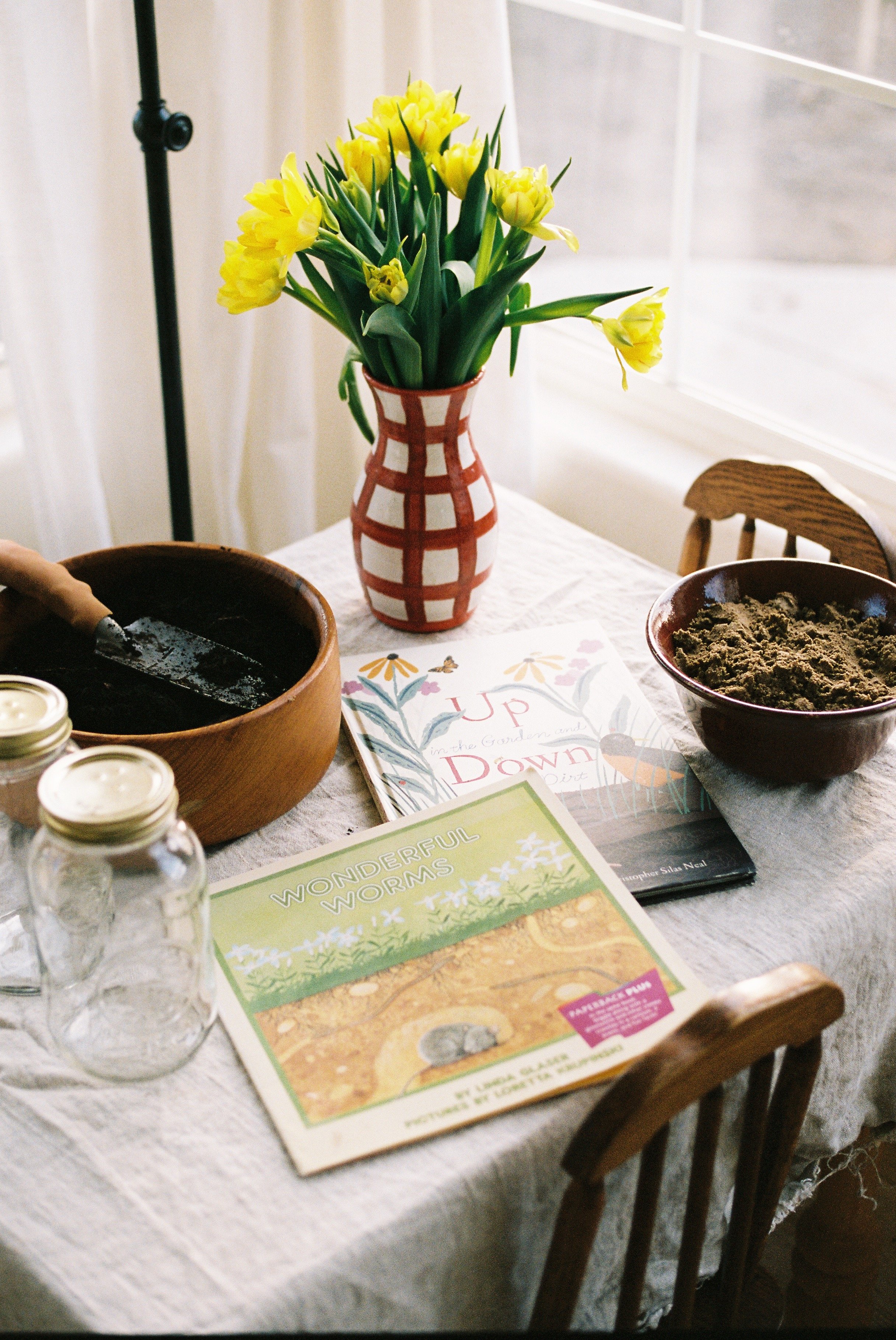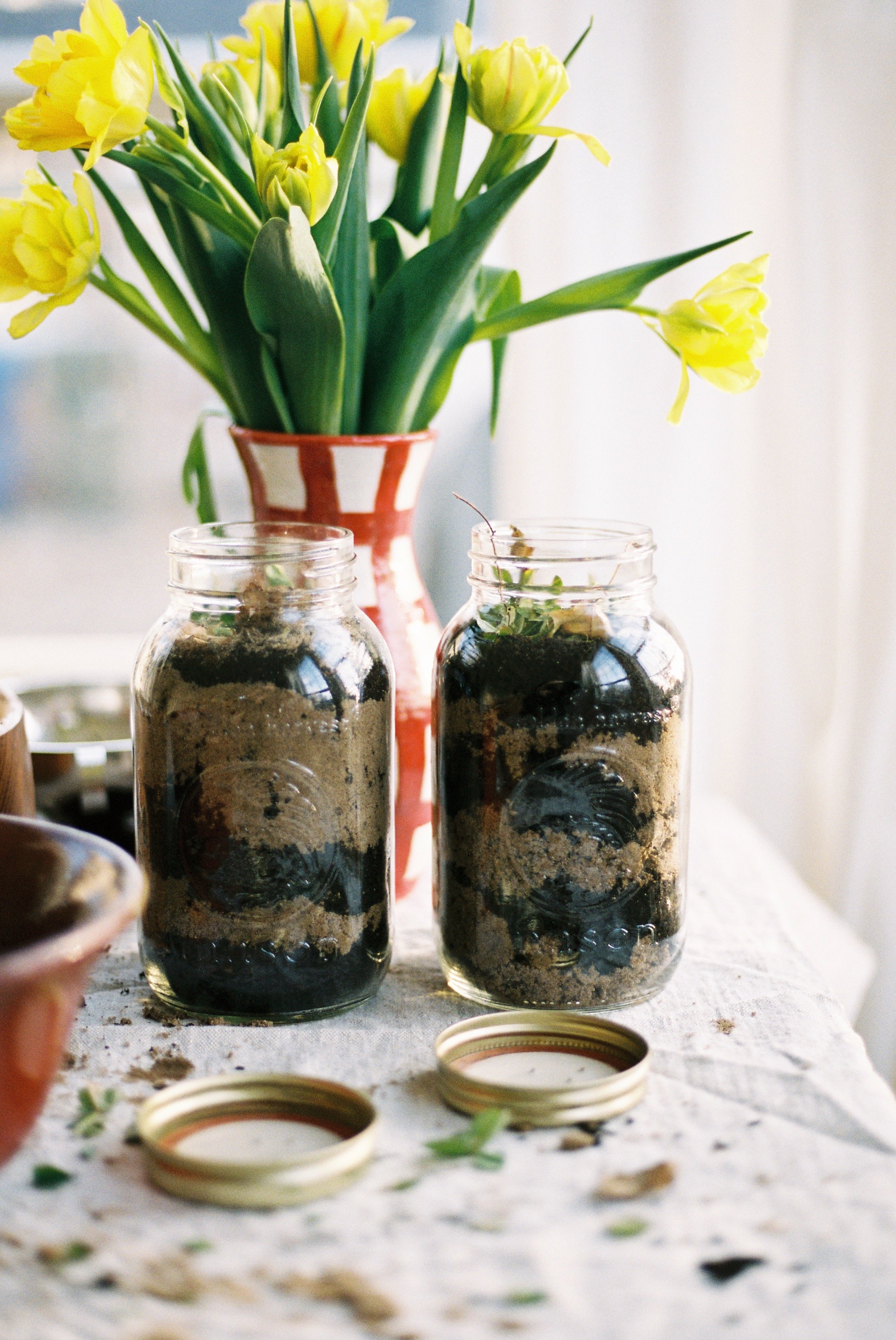
Air and Worms
LESSON 5
Children explore how worms benefit the soil and then make their own wormery using soil and compost.
The book “Wonderful Worms” by Linda Glaser (geared toward younger children), or “Wiggling Worms at Work” by Wendy Pfeffer (geared for older children age 5+).
A large mason jar, glass fishbowl, or clear container
Sand
Compost
Worms (about 5-7)
Materials
Gather materials.
Preparations
Engage children in learning about worms as you read a story together.
Guide children in their understanding of worms as you create a wormery together.
Encourage language development by asking and answering questions about worms.
Foster a love and appreciation of the natural world.
Objectives for Teachers
Objectives for Children
Children explore the importance of worms and how they interact with soil.
Children reflect on their learning throughout the unit as they review parts of the puzzle pieces that make up soil.
Children listen to and learn from a story about worms.
Children discover the needs of worms as they make a wormery using soil and compost.

Collect and Connect
Practice saying the poem “Worm” together with the actions you came up with.
Worm
Worm, worm,
Slippery slide,
I smell a bird,
I better hide.
Down, down,
Under the ground,
Wormy, squirmy,
Around and around.

Activity Flow
Begin this lesson by reviewing what parts of soil we have learned about so far:
Rocks and minerals
Organic matter
Compost
Microbes
2. Refer back to your list of wonders or questions and see if any of them have been answered and add new ones your child might have now that they know more about soil.
3. Tell your child that today we are going to learn about two more things. See if your child can guess what they might be by encouraging them to think about what they have read about in the stories throughout this unit.
4. Next, begin a discussion about compost by checking on your compost jars. Remind the children that compost is made from organic matter that was once alive but is now decomposed by tiny microbes, turning it into nutrient-rich soil. Microbes are also part of the composting process, but unlike compost, they are alive. Then, ask the children what else lives in soil that is alive. Encourage them to share their thoughts and compile a list together, which could include:
Earthworms
Insects like beetles or ants
Bacteria
Fungi
Plant roots
Animals that burrow and live in the soil (moles, mice, snakes, etc.)
5. After creating a list, introduce the story, either “Wonderful Worms” by Linda Glaser (geared toward younger children), or “Wiggling Worms at Work” by Wendy Pfeffer (geared for older children age 5+). Both of these stories explore how worms contribute to soil health and plant growth. “Wiggling Worms at Work” is particularly rich in vocabulary, so take time to discuss any new words your child might encounter. Before diving into the story, explain to the children that they will be learning about the vital role worms play in keeping soil healthy and why they are so important.
6. After the story, initiate a discussion about how worms keep the soil healthy. Here are some questions you might ask:
What did you learn about worms from the story?
How do worms help the soil?
What do worms eat, and what do they do with what they eat?
Why are worms important for plants and gardens?
Can you think of any other ways worms might be helpful in nature?
7. Help your child understand that worms benefit the soil in many ways. They eat organic matter like dead leaves and plants, breaking them down into smaller pieces. As they digest this organic matter, they produce waste called castings, which are rich in nutrients that plants need to grow. Additionally, worms' tunnel through the soil, aerating it and allowing water and air to reach plant roots more easily. Their tunnels also help improve soil structure, making it looser and better for plant roots to grow through. Worms play a vital role in maintaining healthy soil for plants to thrive.
8. Next, introduce the activity for the day. Tell the children that they will be creating a wormery. This is like a little home for worms. Ask what they think a worm home needs to keep the worms alive.
Wormery
Take a mason jar and fill it with layers of sand and compost.
Add organic matter on top of the layers. (Grass, flowers, leaves, etc.)
Add a small amount of water to the jar.
Dig in the dirt to find some worms for the wormery.
Depending on their size, add a few big worms or up to 5-7 smaller ones.
Place the jar in a dark spot.
Check on the worms over the next few weeks to observe how they create tunnels and assist in breaking down the organic matter, turning it into compost.






